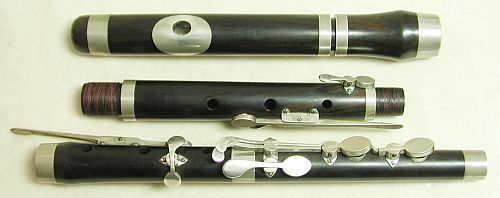
From bottom to top: 1-key boxwood, 9-key cocus, 8-key boxwood, 8-key cocus.
George Catlin (1778–1852) worked in Hartford, Connecticut (1799–1815) and Philadelphia (1816–1850). He claimed to produce "almost every kind of musical instrument now in use..." in advertisements from 1800. According to Robert Eliason, he was "the first important American maker of wind instruments". (Some may know of the painter George Catlin of native American scenes; the instrument maker was a third cousin, once removed, according to The New Langwill Index.)
It is striking about Catlin's flutes that he made so many different types. One is almost tempted to say that no two are the same.

The one-key boxwood flute on the bottom of above photo is stamped Catlin & Bacon / Hartford / Conn. Catlin is known to have been in partnership with A. Bacon in 1812, before a partnership with W. Bliss (1813–14), and a move to Philadelphia in 1815 where he again worked with Bacon before becoming independent in 1818. The other three flutes are stamped G. Catlin / Philada [Philadelphia] and may all have been made circa 1830 or later, except that the boxwood instrument could be a bit earlier. One would never guess that they were made by the same maker were it not for the stamp.

The key of the one-key flute is presumably not original. The flute is a well made classical-style instrument intended to be played in all keys (unlike the one-key Peloubet mentioned in the survey of American flutes). It has hole sizes and, in my opinion, has playing characteristics more closely modeled on German flutes than English. It would have been able to handle Beethoven's orchestral parts.

A nine-key cocuswood flute has salt-spoon keys and medium-small holes. (The metal band at the top of the barrel joint is a repair and not original.)

The keys for low c' and c'# are on the player's side of the D# key, rather than the audience side. This arrangement may be found on some French flutes and can be seen on some, but not all, flutes stamped Drouet / London. I still find it somewhat awkward, but then I am used to the normal arrangement. However, this arrangement of foot joint keys is close in concept to, and suggests the appearance of, the foot joint keys on the earliest Boehm flutes.

The indentations in the wood below the key cups are somwhat oval, as are the two key cups of the Bb keys.


The body of the eight-key boxwood flute has a typical American shape with narrow ivory mounts.

But it appears to be an attempt by Catlin to incorporate the large holes—including the embouchure—of the London-made Nicholson-style flutes. And, indeed, it sounds and plays very much like them.

The keys are simple, with flat, round flaps for leathers.
The last flute, an eight-key cocuswood instrument, was in poor condition when it was acquired. The metal pieces were hanging off the wooden body, with some screws torn out of the wood and lost. The instrument had been stepped on by a horse and the upper center cracked twice, lengthwise, almost end to end. (I'm just kidding about the horse; I don't really know how the center was broken.) The silver bands at either end of the upper center are part of a crude 19th century (?) repair to that joint. Restoration was undertaken by Michael Hubbert. More on this elsewhere.

The elegant silver lip plate, lined embouchure chimney, wide mounts, and keys mounted in saddles, suggest a carefully constructed instrument. The head joint lining is also silver, rather than brass (the other cocuswood instument is also silver lined). The most unusual external feature is the key cups.


These key cups have been called "Hartford spades". Catlin used them on bassoons while still in Hartford. They are like salt-spoon keys in that they are relatively voluminous and probably (?) intended for "purse pads" of some sort. But the retaining sides and the oval metal linings of the tone holes below help insure a good seal.
This flute is the best playing of the flutes on this page, and has the most attractive tone.
Reference: Robert E. Eliason, George Catlin, Hartford Musical Instrument Maker, Journal of the American Musical Instrument Society, 1982 (Part 1) and 1983 (Part 2).
